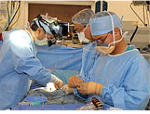


Disclaimer Privacy Policy
Copyright (c) 2021 Bicuspid Aortic Foundation, All Rights Reserved


Creating a Climate of Hope, an Atmosphere of Caring, and Information for All

Advancements
Life-Saving Treatment
Currently, there is no "cure" for thoracic aortic disease once there is degeneration of the tissue. Once present, regardless of the underlying cause, medical and surgical treatment options are available. Aortic surgery has advanced significantly, over a period of about three decades, saving many lives.
Thoracic Aortic Disease - Open Aortic Surgery
Surgery on the Aortic Arch
Surgery on the aortic arch requires special techniques because of the three major arteries
that supply blood to the brain. Any disruption of the blood supply here can result in brain
damage.
The use of total circulatory arrest for aortic arch surgery, reported in the medical literature in
1975, was an important break through, allowing the safe removal of aortic arch aneurysms.
Surgery on the Descending and Thoracoabdominal Aorta
Many smaller vessels branch from this part of the aorta to supply blood to the spinal cord
and organs such as the liver and kidneys. When surgery is done here, the main concerns
are protecting the spinal cord and abdominal organs from harm.
In order to avoid paraplegia and/or liver and kidney failure, more than one surgical technique
has been used on this part of the aorta.
The use of total circulatory arrest under profound hypothermia for the past number of years
has demonstrated significant promise in lowering paraplegia and renal failure.
Other techniques such as left heart bypass or partial circulatory support, as well as the
clamp and sew technique, are also in use in various centers.
TEVAR has also emerged as an option for treatment. This is not open surgery. It involves the
insertion of a stent graft into this portion of the aorta.


- Aorta
- BAV and Other Heart Valves
- Blood Pressure
- Exercise/Weight Lifting
- Featured Papers
- Guidelines
- Familial TAAD
- History
- Honoring Dr. M.E. Abbott
- Pictures (graphic content)
- Pictures Valvular Strand, Aneurysm (graphic)
- Prosthetic Heart Valves
- Scientific Awards
- Spotlight on Research - Coming Soon
- Video (graphic content)
































